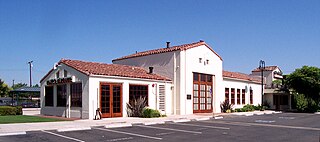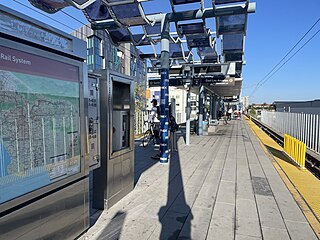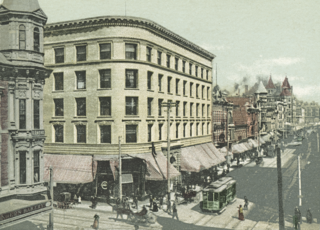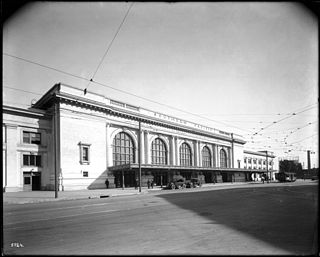
Los Angeles Union Station is the main train station in Los Angeles, California, and the largest passenger rail terminal in the Western United States. It opened in May 1939 as the Los Angeles Union Passenger Terminal, replacing La Grande Station and Central Station.

The Atchison, Topeka and Santa Fe Railway, often referred to as the Santa Fe or AT&SF, was one of the larger railroads in the United States. The railroad was chartered in February 1859 to serve the cities of Atchison and Topeka, Kansas, and Santa Fe, New Mexico. The railroad reached the Kansas–Colorado border in 1873 and Pueblo, Colorado, in 1876. To create a demand for its services, the railroad set up real estate offices and sold farmland from the land grants that it was awarded by Congress.

Santa Fe Depot in San Diego, California, is a union station built by the Atchison, Topeka and Santa Fe Railway to replace the small Victorian-style structure erected in 1887 for the California Southern Railroad Company. The Spanish Colonial Revival style station is listed on the National Register of Historic Places and is a San Diego Historic Landmark. Its architecture, particularly the signature twin domes, is often echoed in the design of modern buildings in Downtown San Diego.
Santa Fe Depot, Santa Fe Passenger Depot, or variations may refer to many train stations in the United States once operated by the Atchison, Topeka & Santa Fe Railway, including:

The Fullerton Transportation Center is a passenger rail and bus station located in Fullerton, California, United States.

The Santa Ana Regional Transportation Center is a passenger rail station and transportation center in Santa Ana, California. It is used by Amtrak's Pacific Surfliner and Metrolink's Orange County Line and Inland Empire–Orange County Line trains. It is also a Greyhound station and a hub for the Orange County Transportation Authority bus system as well as a terminal for international bus services to Mexico.

Orange station, formally the Orange Transportation Center, is an intermodal transit station in Orange, California. It serves Metrolink trains as well as Orange County Transportation Authority buses. The station is located at the site of two former Atchison, Topeka and Santa Fe Railway combination depots. The present depot structure was dedicated on May 1, 1938, and was closed with the Santa Fe's discontinuation of passenger service in 1971. The building was granted historic landmark status by the City on November 15, 1990.

The San Bernardino Santa Fe Depot is a Mission Revival Style passenger rail terminal in San Bernardino, California, United States. It has been the primary station for the city, serving Amtrak today, and the Santa Fe and Union Pacific Railroads in the past. Until the mid-20th century, the Southern Pacific Railroad had a station 3/4 of a mile away. It currently serves one Amtrak and two Metrolink lines. The depot is a historical landmark listed on the National Register of Historic Places as Atchison, Topeka and Santa Fe Railway Passenger and Freight Depot.

Culver City station is an elevated light rail station on the E Line of the Los Angeles Metro Rail system. The station is located on a dedicated right-of-way alongside Exposition Boulevard — between the intersection of Venice Boulevard and Robertson Boulevard on the west and the intersection of Washington Boulevard and National Boulevard on the east. The station is located in the city of Culver City, California, after which the station is named. The station served as the western terminus of the line from its opening on June 20, 2012, until the opening of the extension of the line to Santa Monica on May 20, 2016.

The Fullerton Line was an interurban route of the Pacific Electric Railway. It ran between Downtown Los Angeles and Fullerton, California. It opened in 1917 and saw freight service until the 1940s.

The Long Beach Line was a major interurban railway operated by the Pacific Electric Railway between Los Angeles and Long Beach, California via Florence, Watts, and Compton. Service began in 1902 and lasted until 1961, the last line of the system to be replaced by buses.

7 was a streetcar line in Los Angeles, California. The service was operated by the Los Angeles Railway from 1932 to 1955. It ran from Spring and 2nd Streets to Athens and 116th Street, by way of Spring Street, Main Street, Broadway Place, Broadway, and Athens Way. During its Los Angeles Transit Lines days, around 1950 to 1955, Line 7 was rerouted off South Broadway to Central Avenue, at least as far north as 7th Street across Olympic Boulevard to possibly Vernon Avenue, covering trackage that was abandoned rail by line U, when that line was converted to trolley bus August 3, 1947.
9 was a streetcar line in Los Angeles, California. It was operated by the Los Angeles Railway from 1932 to 1955.

The Los Angeles and San Gabriel Valley Railroad was a railroad founded on September 5, 1883, by James F. Crank with the goal of bringing a rail line to Pasadena, California from downtown Los Angeles, the line opened in 1886. Los Angeles and San Gabriel Valley Railroad was sold and consolidated on May 20, 1887 into the California Central Railway. In 1889 this was consolidated into Southern California Railway Company. On Jan. 17, 1906 Southern California Railway was sold to the Atchison, Topeka and Santa Fe Railway and called the Pasadena Subdivision. The main line closed in 1994. The railroad later reopened as the MTA Gold Line Light Rail service in July 2003.

The California Central Railway was incorporated on April 23, 1887, with headquarters in San Bernardino, California. George O. Manchester was the President of the corporation.

The Long Wharf in Santa Monica, also known as Port Los Angeles or the Mile Long Pier, was an extensive pier wharf constructed by the Southern Pacific Railroad Company in Santa Monica Bay from 1892–94. When it opened in 1894, it was the longest wharf in the world, measuring approximately 4,700 feet (1,400 m). It served as a cargo and passenger port until 1913, and in 1919 removal of the wharf started. The wharf, the 1,000 foot (300 m) tip of the pier, was removed by 1920. The remaining 3,600 feet (1,100 m) of pier was used as a run down fishing pier until 1933, when the remainder of the pier was removed. One of the major imports to the wharf was lumber from Northern ports, to help in the construction boom in Southern California. Southern Pacific Railroad and the street cars of the Los Angeles Pacific Railroad served the wharf. Los Angeles Pacific Railroad ran passenger trams to the wharf and from midnight to sunrise ran cargo cars.

Central Station was the Southern Pacific Railroad's main passenger terminal in Los Angeles, California. It was formerly on Central Avenue at Fifth Street, in eastern Downtown Los Angeles. The primary hub for Southern Pacific's passenger operations in Southern California, it was served by the Sunset Limited, Coast Daylight, Golden State, and other named trains. The station replaced the company's previous Los Angeles terminal, Arcade Depot, and was often referred to by the name of the older facility.

Redlands–Downtown station is a rail station serving downtown Redlands, California, United States. The station was built in 1910 for the Atchison, Topeka and Santa Fe Railway and operated until 1938. The facility was preserved and reopened on October 24, 2022 as part of the Arrow commuter rail service.

Riverside Depot is a former train station in Riverside, California.

The Venice–Inglewood Line is a former Pacific Electric interurban railway line in Los Angeles County, California. Service was very sparse, providing a suburban route between Venice and Inglewood.





















